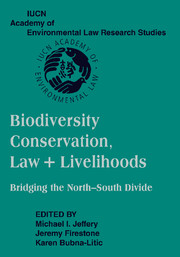 Biodiversity Conservation, Law and Livelihoods: Bridging the North-South Divide
Biodiversity Conservation, Law and Livelihoods: Bridging the North-South Divide Published online by Cambridge University Press: 31 July 2009
INTRODUCTION
Although scientists and farmers have for centuries engaged in plant manipulation and cross-breeding, it was not until the discovery of the DNA molecule in 1953 that a new mode of genetic manipulation was made possible. Agricultural biotechnology now utilizes recombinant DNA techniques to transfer genes between species and from one cell to another. As such, the resultant genetically modified organisms (GMOs) can draw from a more diverse gene pool and offer valuable phenotypes not available through conventional breeding. The so-called first generation GM crops, that is, those modified for resistance to insect pests, herbicides, and viruses, have mostly benefited producers of GMOs, whereas second-generation crops are in the process of development and they are more likely to benefit consumers.
The development of genetically modified foods has mushroomed since 1953. It is now estimated that the United States has 72 percent, Argentina 17 percent, and Canada 10 percent of its agricultural land planted with genetically modified crops. The technology of genetically modified organisms is still relatively new, however, and, as with any new technology, it carries some level of risk. Harm can occur in a number of circumstances from the cradle to the grave route of biotechnology and some risks such as safety and health hazards are as yet undetermined. Other risks have been clearly established. For example, approximately nine class action suits have been brought in the United States against the biotech company Aventis over the contamination of corn.
To save this book to your Kindle, first ensure [email protected] is added to your Approved Personal Document E-mail List under your Personal Document Settings on the Manage Your Content and Devices page of your Amazon account. Then enter the ‘name’ part of your Kindle email address below. Find out more about saving to your Kindle.
Note you can select to save to either the @free.kindle.com or @kindle.com variations. ‘@free.kindle.com’ emails are free but can only be saved to your device when it is connected to wi-fi. ‘@kindle.com’ emails can be delivered even when you are not connected to wi-fi, but note that service fees apply.
Find out more about the Kindle Personal Document Service.
To save content items to your account, please confirm that you agree to abide by our usage policies. If this is the first time you use this feature, you will be asked to authorise Cambridge Core to connect with your account. Find out more about saving content to Dropbox.
To save content items to your account, please confirm that you agree to abide by our usage policies. If this is the first time you use this feature, you will be asked to authorise Cambridge Core to connect with your account. Find out more about saving content to Google Drive.